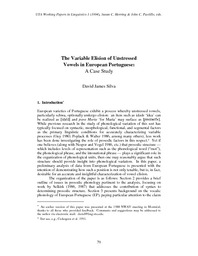
ATTENTION: The works hosted here are being migrated to a new repository that will consolidate resources, improve discoverability, and better show UTA's research impact on the global community. We will update authors as the migration progresses. Please see MavMatrix for more information.
Show simple item record
| dc.contributor.author | Silva, David J. | en_US |
| dc.date.accessioned | 2008-11-18T23:26:29Z | |
| dc.date.available | 2008-11-18T23:26:29Z | |
| dc.date.issued | 1994 | |
| dc.identifier.citation | Silva, David James. 1994. The variable elision of unstressed vowels in European Portuguese: a case study. UTA Working Papers in Linguistics 1.79-94. | en_US |
| dc.identifier.uri | http://hdl.handle.net/10106/1188 | |
| dc.description.abstract | **Please note that the full text is embargoed** ABSTRACT: European varieties of Portuguese exhibit a process whereby unstressed vowels, particularly schwa, optionally undergo elision: an item such as idade ‘idea’ can be realized as [ida'd] and para Maria ‘for Maria’ may surface as [prɐmɐrí'ɐ]. While previous research in the study of phonological variation of this sort has typically focused on syntactic, morphological, functional, and segmental factors as the primary linguistic conditions for accurately characterizing variable processes (Guy 1980; Poplack & Walter 1986, among many others), less work has been done investigating the role of prosodic factors in this respect. Yet if one believes (along with Nespor and Vogel 1986, etc.) that prosodic structure — which includes levels of representation such as the phonological word (“mot”), the phonological phrase, and the intonational phrase — plays a significant role in the organization of phonological units, then one may reasonably argue that such structure should provide insight into phonological variation. In this paper, a preliminary analysis of data from European Portuguese is presented with the intention of demonstrating how such a position is not only tenable, but is, in fact, desirable for an accurate and insightful characterization of vowel elision.
The organization of the paper is as follows: Section 2 provides a brief outline of issues in prosodic phonology pertinent to the analysis, focusing on work by Selkirk (1986, 1987) that addresses the contribution of syntax to determining prosodic structure. Section 3 presents background on the vocalic phonology of European Portuguese (EP), paying particular attention to the claim that varieties of EP characteristically weaken unstressed non-low vowels. Section 4 reports on a case study of conversational speech produced by one speaker of EP from the Azorean island of Faial. Statistical analysis of these data reveals that conditions promoting vowel elision include both segmental and prosodic factors, chief among the latter being the notion of “word-edge”. | en_US |
| dc.language.iso | en_US | en_US |
| dc.publisher | Linguistics & TESOL | en_US |
| dc.subject | Language variation | en_US |
| dc.subject | Vowel elision | en_US |
| dc.subject | European Portuguese | en_US |
| dc.subject | Prosodic phonology | en_US |
| dc.title | The variable elision of unstressed vowels in European Portuguese: a case study | en_US |
| dc.type | Article | en_US |
| dc.type | Working Paper | en_US |
Files in this item
- Name:
- 79-94-Silva.pdf
- Size:
- 120.4Kb
- Format:
- PDF
This item appears in the following Collection(s)
Show simple item record


